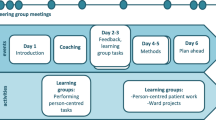Abstract
The aim of this study was to evaluate an intervention programme for people with severe mental illness that targets the reduction in compulsory psychiatric admissions. In the current study, we examine the feasibility of retaining patients in this programme and compare outcomes over the first 12 months to those after treatment as usual (TAU). Study participants were recruited in four psychiatric hospitals in the Canton of Zurich, Switzerland. Patients were eligible if they had at least one compulsory admission during the past 24 months. Participants were assigned at random to the intervention or to the TAU group. The intervention programme consists of individualised psycho-education focusing on behaviours prior to illness-related crisis, crisis cards and, after discharge from the psychiatric hospital, a 24-month preventive monitoring. In total, 238 (of 756 approached) inpatients were included in the trial. After 12 months, 80 (67.2 %) in the intervention group and 102 (85.7 %) in the TAU group were still participating in the trial. Of these, 22.5 % in the intervention group (35.3 % TAU) had been compulsorily readmitted to psychiatry; results suggest a significantly lower number of compulsory readmissions per patient (0.3 intervention; 0.7 TAU). Dropouts are characterised by younger age and unemployment. This interim analysis suggests beneficial effects of this intervention for targeted psychiatric patients.


Similar content being viewed by others
References
Katsakou C, Bowers L, Amos T, Morriss R, Rose D, Wykes T et al (2010) Coercion and treatment satisfaction among involuntary patients. Psychiatr Serv 61:286–292
Jaeger M, Rossler W (2010) Enhancement of outpatient treatment adherence: patients’ perceptions of coercion, fairness and effectiveness. Psychiatry Res 180:48–53
Bonsack C, Borgeat F (2007) Perceived coercion and need for hospitalization related to psychiatric admission. Int J Law Psychiatry 28:342–347
Branik E (2004) Auswirkungen von Zwangsbehandlungen und -massnahmen auf die klinische und Beziehungsarbeit in der stationären Kinder-und Jugendpsychiatrie. Schweiz Arch Neurol Psych 155:118–124
Arboleda-Flórez J (2011) Psychiatry and the law—do the fields agree in their views on coercive treatment? In: Kallert TW, Mezzich JE, Monahan J (ed) Coercive treatment in psychiatry: clinical, legal and ethical aspects, vol 6. Wiley, Chichester, pp 83–96
Dressing H, Salize HJ (2004) Nehmen Zwangsunterbringungen psychisch Kranker in den Ländern der Europäischen Union zu? [Is there an increase in the number of compulsory admissions of mentally ill patients in European Union Member States?]. Gesundheitswesen 66:240–245
Lay B, Nordt C, Rössler W (2011) Variation in use of coercive measures in psychiatric hospitals. Eur Psychiatry 26:244–251
Salize HJ, Dressing H (2004) Epidemiology of involuntary placement of mentally ill people across the European Union. Br J Psychiatry 184:163–168
Barrett B, Waheed W, Farrelly S, Birchwood M, Dunn G, Flach C et al (2013) Randomised controlled trial of joint crisis plans to reduce compulsory treatment for people with psychosis: economic outcomes. PLoS ONE 8:e74210
Bäuml J, Pitschel-Walz G, Volz A, Engel RR, Kissling W (2007) Psychoeducation in schizophrenia: 7-year follow-up concerning rehospitalization and days in hospital in the Munich Psychosis Information Project Study. J Clin Psychiatry 68:854–861
Krischke N (2006) Sozialpsychiatrische Gesundheitspsychologie. Qualitätssicherung in der Zwangseinweisungspraxis. Psychiatrie, Bonn
Henderson C, Flood C, Leese M, Thornicroft G, Sutherby K, Szmukler G (2004) Effect of joint crisis plans on use of compulsory treatment in psychiatry: single blind randomised controlled trial. BMJ 329:122–123
Moran P, Borschmann R, Flach C, Barrett B, Byford S, Hogg J et al (2010) The effectiveness of joint crisis plans for people with borderline personality disorder: protocol for an exploratory randomised controlled trial. Trials 11:18–25
Thornicroft G, Farrelly S, Birchwood M, Marshall M, Szmukler G, Waheed W et al (2010) CRIMSON [CRisis plan IMpact: Subjective and Objective coercion and eNgagement] Protocol: a randomised controlled trial of joint crisis plans to reduce compulsory treatment of people with psychosis. Trials 11:102
ZInEP (2009) http://www.zinep.ch/en Accessed 3 Sept 2014
Lay B, Salize H, Dressing H, Rüsch N, Schönenberger T, Bühlmann M et al (2012) Preventing compulsory admission to psychiatric inpatient care through psycho-education and crisis focused monitoring. BMC Psychiatry 12:136. doi:10.1186/1471-244X-12-136
FMH Swiss Medical Association (2013) http://www.fmh.ch/politik_themen/aerztedemographie.html. Accessed 3 Sep 2014
Chisholm D, Knapp M, Knudsen HC, Amaddeo F, Gaite L, Van Wijngaarden B (2000) Client Socio-demographic and Service Receipt Inventory—European version: development of an instrument for international research: EPSILON Study 5. Br J Psychiatry 177:s28–s33
Thornicroft G, Farrelly S, Szmukler G, Birchwood M, Waheed W, Flach C et al (2013) Clinical outcomes of joint crisis plans to reduce compulsory treatment for people with psychosis: a randomised controlled trial. Lancet 381:1634–1641
Borschmann R, Barrett B, Hellier JM, Byford S, Henderson C, Rose D et al (2013) Joint crisis plans for people with borderline personality disorder: feasibility and outcomes in a randomised controlled trial. Br J Psychiatry 202:357–364
Flood C, Byford S, Henderson C, Leese M, Thornicroft G, Sutherby K et al (2006) Joint crisis plans for people with psychosis: economic evaluation of a randomised controlled trial. BMJ 333:729–734
Swanson JW, Swartz MS, Elbogen EB, Van Dorn RA, Ferron J, Wagner HR et al (2006) Facilitated psychiatric advance directives: a randomized trial of an intervention to foster advance treatment planning among persons with severe mental illness. Am J Psychiatry 163:1943–1951
Papageorgiou A, King M, Janmohamed A, Davidson O, Dawson J (2002) Advance directives for patients compulsorily admitted to hospital with serious mental illness: randomised controlled trial. Br J Psychiatry 181:513–519
Campbell MK, Snowdon C, Francis D, Elbourne DR, McDonald AM, Knight RC et al (2007) Recruitment to randomised trials: strategies for trial enrolment and participation study. The STEPS study. Health Technol Assess 11:1–123
Conflict of interest
The authors declare that they have no conflict of interest.
Author information
Authors and Affiliations
Corresponding author
Rights and permissions
About this article
Cite this article
Lay, B., Blank, C., Lengler, S. et al. Preventing compulsory admission to psychiatric inpatient care using psycho-education and monitoring: feasibility and outcomes after 12 months. Eur Arch Psychiatry Clin Neurosci 265, 209–217 (2015). https://doi.org/10.1007/s00406-014-0553-1
Received:
Accepted:
Published:
Issue Date:
DOI: https://doi.org/10.1007/s00406-014-0553-1




